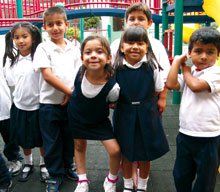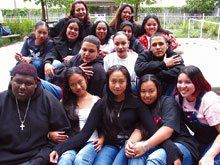Our Mission: “Educate students for lifelong learning and responsible living.”
Our Vision: “Provide a learning environment that promotes and develops academic and
social growth.”
PreK and Kindergarten Round Up.
- Monday, April 30, 2018. Lesson Plan Check. Fourth Grade Field Trip - Fishing
- Tuesday, May 1, 2018. Thunder Bus, PLC Meetings, 1 Hour Virtual Faculty Meeting.
- Wednesday, May 2, 2018.
- Thursday, May 3, 2018. Kona Ice. Progress Reports Go Home in Thursday Folders.
- Friday, May 4, 2018. Track Meet, Capitol Hill High School
Google Classroom - Faculty Meeting Professional Development. Be sure you complete prior to May 1, 4:00. You must hit submit.
Recess: Please be sure you are monitoring recess.
Recess Struggles: Students Help Teachers Maintain a Peaceful Playground
Aiming for Discipline Instead of Punishment
Brain-aligned discipline isn’t compliance-driven or punitive—it’s about supporting students in creating sustainable changes in behavior.
There are many perspectives on the topic of discipline in our classrooms and schools, and I’d like to explore the idea of using brain-aligned discipline with students who have adverse childhood experiences (ACEs).
Traditional punishment with these students only escalates power struggles and conflict cycles, breeding an increased stress response in the brain and body. Punishment is used to try to force compliance. The vast majority of school discipline procedures are forms of punishment that work best with the students who need them the least.
With our most difficult students, the current way schools try to discipline students does not change their behavior, and often it escalates the problems.
Discipline, unlike punishment, is proactive and begins before there are problems. It means seeing conflict as an opportunity to problem solve. Discipline provides guidance, focuses on prevention, enhances communication, models respect, and embraces natural consequences. It teaches fairness, responsibility, life skills, and problem solving.
There are times when students need to be removed from the classroom and school for aggressive, volatile actions, but upon re-entry we should make a plan of action that begins to address these actions in these brain-aligned ways.
The neurobiological changes caused by chronic negative experiences and a history of adversity can trigger a fear response in the brain. As Pam Leo says, “A hurtful child is a hurt-filled child. Trying to change her behavior with punishment is like trying to pull off only the top part of the weed. If we don’t get to the root, the hurtful behavior pops up elsewhere.” In children the fear response often looks aggressive, defiant, and oppositional.
Young people with ACEs have brains that are in a constant state of alarm. In this alarm state, consequences don’t register properly. Discipline can only be done when both the educator and the student are calm and self-regulated. If they aren’t, behavioral difficulties will escalate.
In a brain-aligned model of discipline, we must teach the behaviors we want to see, laying the groundwork for prevention systems and strategies.
PREVENTIVE BRAIN-ALIGNED STRATEGIES
Preventive systems are taught as procedures and routines. They are collaborative and filled with choice. Their purpose is to create a sustainable behavioral change, not just compliance or obedience for a short period of time.
I teach students about their neuroanatomy, so they understand what happens in their brains when they become stressed, angry, or anxious. When we understand this, we feel relieved and empowered.
In morning meetings or whole class time, I discuss the prefrontal cortex, amygdala, and neuroplasticity with students. We identify and make lists of our emotional triggers and coping strategies, and I teach students to use their breath and movement to calm their stress response systems.
Is there an adult in the school who connects with this student and has a space where the student can go if they need to regroup and calm their stress response systems? Are you teaching these procedures ahead of a time when a student needs to regulate away from the class?
Could your school create a area for both teachers and students to go to when they need to reset their emotional state? This area could be stocked with paper, markers, crayons, water, soft music and lighting, a jump rope, a stationary bike, lavender scented cotton balls, jars for affirmations or worries, or a rocking chair. Students will need to be taught ahead of time how to use this area, which they should need for just two to five minutes in order to feel refocused and ready to return to class.
EXAMPLES OF NATURAL, NON-PUNITIVE CONSEQUENCES
Name-calling: Have the student create a book of positive affirmations for the class, or have them create a list of “kind words” and teach them to a younger class.
Low-level physical aggression (pushing, kicking, hitting): Some consequences could include giving the student a new learning space in the room or a new spot in line, or they could be tasked with performing an act of kindness or service for the hurt person.
If this occurs at recess, the student could be tasked with assisting a teacher on recess duty in monitoring the playground, noticing everything that is going well. They can roam around the playground, still getting the exercise they need. Or again they could perform an act of kindness toward the student who they hit.
Inappropriate language: This calls for a discussion when both student and teacher are in a calm brain state. Sometimes words that are inappropriate at school are used at home, so we need to understand the cultural context and have a discussion with the student.
An older student could research the words they used and report to you on why they’re not school words; younger students could try to write out what they were trying to convey using school-friendly language or drawings.
Incomplete assignments: Have a one-on-one discussion to convey what this behavior communicates to you. Ask if something has changed at home or school, or if the student doesn’t understand what is required. Make a plan with the student and possibly a parent for making up the work that has been missed. And consider assigning a student mentor to help the student.
The research is clear. Our brains learn best in a state of relaxed alertness. Our discipline systems must begin to shift toward creating this state in all the members of our school community.
To Develop Every Child Into a Reader:
- Everyday a child reads something they choose to read.
- Every child reads accurately
- Every child reads something they understand.
- Every child writes something that is personal and meaningful daily.
- Every child talks with peers about reading and writing.
- Every child hears an adult reader read fluently.
Coolidge Elementary Academic Goals for 2017- 2018
- All Students WILL achieve academically.
- Reading: Increase reading proficiency by at least one grade level, and know their current F & P level.
- Math: Increase math achievement by 10% with 80% mastery of math facts on grade level.
- Writing: Increase writing proficiency by 15%
- Student Attendance: Increase student attendance to 98%.
- Increase Faculty Attendance to 98%
OKCPS Literacy Standards
OKCPS Math Standards
Melissa Brett | Principal
Coolidge Elementary School | Oklahoma City Public Schools
5212 S. Villa, Oklahoma City, OK 73119
(405) 587-2800
(405) 208-1581 (cell)





No comments:
Post a Comment